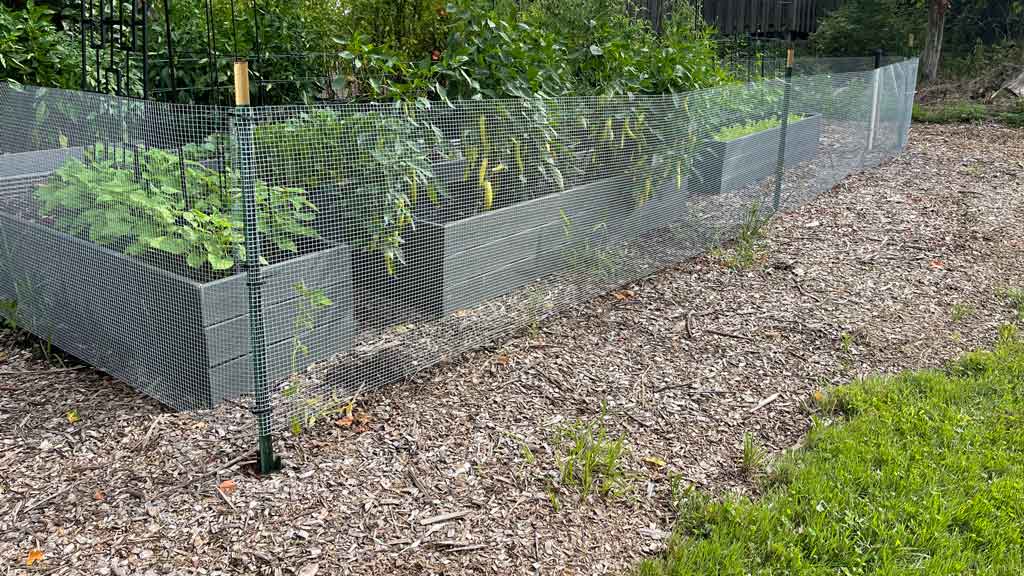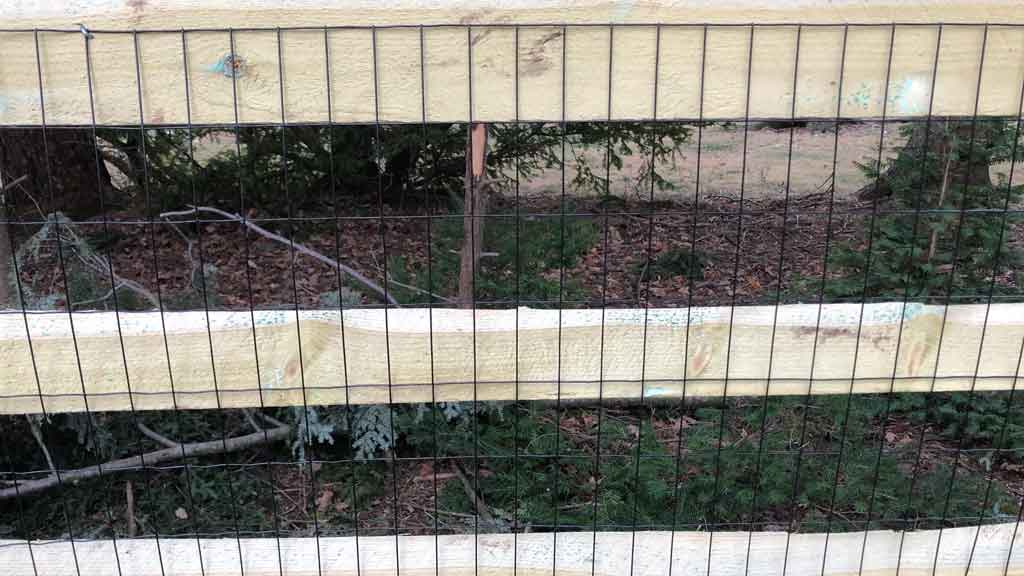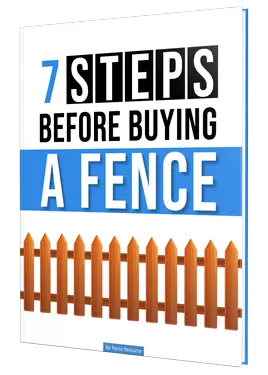Welded wire fence is metal fence with thin horizontal and vertical strands of wire welded together where they intersect. A more affordable option when compared to other types of wire fence.
Used for residential and light farming purposes. It is manufactured in multiple height and mesh size options. Therefore, making welded wire fence suitable for many applications.
Welded Wire Fence Options

Welded wire fence sells in two forms. Rolls and panels. The rolls of fence are much longer. Therefore, cheaper per foot when compared to panels.
Normal roll lengths are 50′ and 100′ long. Use full length rolls when fencing in backyards and small pastures.
Welded wire fence panels are much shorter in length. The longest are cattle panels which measure 16′ wide. The majority will be 8′ wide or less.
Panels are better suited for smaller projects and for fill on wood and wire fence. However, rolls and panels are just two of the options you’ll find.
Height Options
Both the panels and the rolls of fence come in many heights. Standard heights start at 18″ tall and go up to 72″ tall. The intended purpose of the fence will influence the decision on height.
Shorter 18″ – 24″ tall heights with smaller mesh sizes are great for keeping gardens safe from unwanted animals. Heights of 48″ – 60″ tall are common for containing dogs as well as medium sized farm animals such as sheep and goats.
Taller 72″ tall versions having 2″ x 4″ mesh are good for keeping unwelcome deer out of areas.
Mesh Sizes

There are many different sizes of mesh that welded wire fence comes in. Just like the height of the fence, the purpose of the fence will determine the mesh size.
Standard sizes start as small as 1/2″ x 1″ and go up to 2″ x 4″. Containing baby chics or for the floor of a rabbit cage are common uses for welded wire fence with small mesh sizes. Larger sizes are good for containing bigger animals.
What About Gauge?
The gauge of wire is a unit of measurement describing its thickness. The larger the gauge number the smaller the actual size of the wire.
Welded wire fence comes in many different gauges. Standard sizes start at 17 gauge and go up to 12.5 gauge for welded wire fence sold in rolls. Some of the heavier welded wire fence cattle panels use a much heavier 4 gauge wire.
Therefore, providing the strength needed to corral cattle. Smaller height fence generally will have lighter gauge wire. With the heavier gauge wire used for taller heights.
Welded Wire Fence Colors

Most welded wire fence comes galvanized. Therefore, it will have a natural silver color due to the coating. At first, it will be shiny. However, the galvanization will oxidize and turn more of a flat gray color.
Some manufacturers offer green and black colors. The wire strands of colored fence still have the galvanized coating underneath the vinyl coating. The coating then gives the fence its color along with adding extra protection to the wire strands.
Vinyl coated options blend in better than the silver galvanized. As result, making them more widely used in residential applications.
How Long Does Welded Wire Fence Last?
Galvanized welded wire fence will last 15 – 20 years. Vinyl coated options will last 10 – 15 years. Remember, it is a cheaper solution than other types of wire fence.
If you are looking for a long life expectancy, other options will last longer. The coating of the fence and purpose of it will influence life expectancy as well.
Even with most galvanized welded wire fences, surface rust will occur after only a few years.
Vinyl coatings help protect the wire from the elements. However, vinyl coated options usually use thinner gauged steel wire for the core. Therefore, making them weaker.
Not to mention, any cuts or scratches to the coating, and water will find a way in. Overtime, rusting from inside. The coating looses its bond and will crack or peel when this happens.
For the longest lasting fence, look for hot dipped galvanized. This has a much thicker coating then the electro-galvanized coated fence. Even the hot dip galvanization comes in two classes.
Class 1 and Class 2. With Class 2 having a thicker coating. Fences in highly corrosive areas will benefit from Class 2 galvanization.
For example: Fences along roads where rock salt is used in the winter. Or costal regions where salt spray from the ocean is high.
How to Install Welded Wire Fence
It isn’t hard to install wire fence for most applications. There are only really two parts to the fence. The fence posts and the wire mesh.
However, because the strands are welded together forming perfect ninety degree angles, it does not flow well over uneven terrain. Especially when fence lines are long. Therefore, it is better suited for short runs installed on level ground.
Installing the Posts

Unlike all other types of wire fence, welded wire does not need stretched in order to support itself. Therefore, the need for huge end and corner posts with cross bracing is not required.
However, it is a good idea to pull the fence tight on longer runs to remove slack and waviness. Wooden and metal T-posts or star pickets are most popular. Both can be driven into the ground.
However, wood posts will require a special post driver attached to a skidsteer or tractor. T-posts and star pickets can be driven with a hand held driver or sledge hammer.
The distance between fence posts will add or take away from the strength of the fence. Normal post spacings are 8′, 10, and 12′ on center.
The fence attaches to the posts using a fencing staple for wood posts and a fence clip or tie for the metal posts.
Stretching Welded Wire Fence
As mentioned before, welded wire fence supports itself and doesn’t require stretching for shorter runs. However, longs lines of fence require slack to be pulled out. This prevents the fence from looking waves and loose.
Stretch or pull fence lengths shorter than 50′ in length by hand. A two person job, one person pulls the wire while the other fastens it to the fence posts. Done one post at a time, it requires no special tools.
Longer lines of fence will require pulling or stretching in order for the fence to stand upright and tight. However, do not over stretch welded wire fence. Doing so results in broken strands of wire or broken welds where the wires intersect.
Remember, the wire itself does not need stretched. We are just trying to remove the slack from it.
Tools are needed to stretch longer fence lines. A field fence stretch bar is the first. Designed for woven wire and welded wire fence. The second is a come-a-long or two for applying tension.
A stretch bar has two pieces that bolt together through the holes in the fence and clamp onto the wire. Installed 5′ – 10′ inward from the end of the fence line. However, when more slack needs removed, install the stretch bar further from the post.
The come-a-long hooks to the end post on one end and the stretch bar on the other. Crank the com-a-long until the fence is tight.
Next, bounce the fence from the center point of the fence line. This allows tension to spread evenly through the line of fence.
With the come-a-long still attached, fasten the fence to all of the posts except the end post. Release the tension and fasten the remaining loose end of fence to the end post, pulling tight by hand.
Pro Fence Tip – Using Household Materials to Stretch Wire Fence
Make a homemade stretch bar with a 2×4 and nuts and bolts. Cut two length of the 2×4 to the same height as the fence.
Drill holes through them in order to bolt them together. One hole per foot of the height of the wire will work. Use wood screws to screw the 2x4s together in place of nuts and bolts.
Use ratchet straps instead of come-a-longs for applying tension. For extra leverage, use two. One towards the top and one towards the bottom. About 12″ from each end of the stretch bar.
Insert the hook from the tail end through the fence, around the 2x4s and back to the strap. Attach the hook on the cranking end to the end post.
A short length of rope or wire in the shape of a loop makes for an easy attachment. Then crank both evenly using the methods described above!!!
Welded Wire Fence Panel Installation
Installing welded wire fence panels is simple. Set the posts to the lenght of the panel for wood and wire style fences. Shorter lengths require cutting the panels down to the correct size.
Attach the panel to the wood posts and framework using fence staples. Use trim boards to cover fasteners and the edges of the panels.
Panels used in conjunction with metal T-posts or star pickets like cattle panels will overlap slightly at each post. This adds extra strength at the joints. Fasten the panels using steel fence ties or fence clips.

